The September shakes: 5 reasons this market has further to run
September and October are typically weak seasonal times for equity markets. So far, for September, the ASX200, S&P500 and MSCI World ex-Australia in Australian dollar terms are down 3.4%, 2.7% and 2.4%, respectively. However, let us put the decline into context.
From the Covid Crisis low on 23 March 2020, these same markets are up 60%, 56% and 54%, respectively (the returns are even higher after dividends). The National Bureau of Economic Research has also determined the US had its shortest recession on record lasting from February to April 2020, which means we are approximately 17 months into the current economic cycle. Previous work done by Morgan Stanley indicated that this cycle is likely going to be shorter, given notable parallels with US cycles in the 1940s. During this era, the average cycle length was 44 months, which suggests we are not even halfway through this cycle.
We acknowledge that this cycle's "easy money" is likely behind us as our return expectations are more subdued from here.
Ultimately, we maintain our
view that equity markets will be higher in 12 months. As multi-asset investors,
we use our growth and defensive asset allocations to manage volatility and
position our return expectations. This work leads us to maintain our view that
investors should remain positively exposed to growth assets. Besides history, following
are five reasons why we suggest investors should remain overweight growth
assets.
1. Commodity Prices
The sharp fall in iron ore prices has been a contributing factor to the broader market weakness. From the highs of around US$230/tonne back in May, iron ore prices collapsed into the US$90s during September. Various issues emanating from China have been behind this fall (more on this in a moment). Still, iron ore's woes have not spread to other commodities, as seen in the Invesco Commodity Composite UCITS ETF (London: LGCU). This ETF holds a basket of 24 hard and soft commodities (including energy) and, over the same period above, has returned 3.2% (see Exhibit 1). Breaking the basket down, we can observe that commodities like Aluminum, Oil and Nickel have risen in value. Iron ore is a big part of the resource sector in Australia, but it is not the only area where investors can find good returns. We continue to see commodities as an essential component of a well-diversified portfolio.
Exhibit 1 – Commodities ex-Iron ore are generally holding up
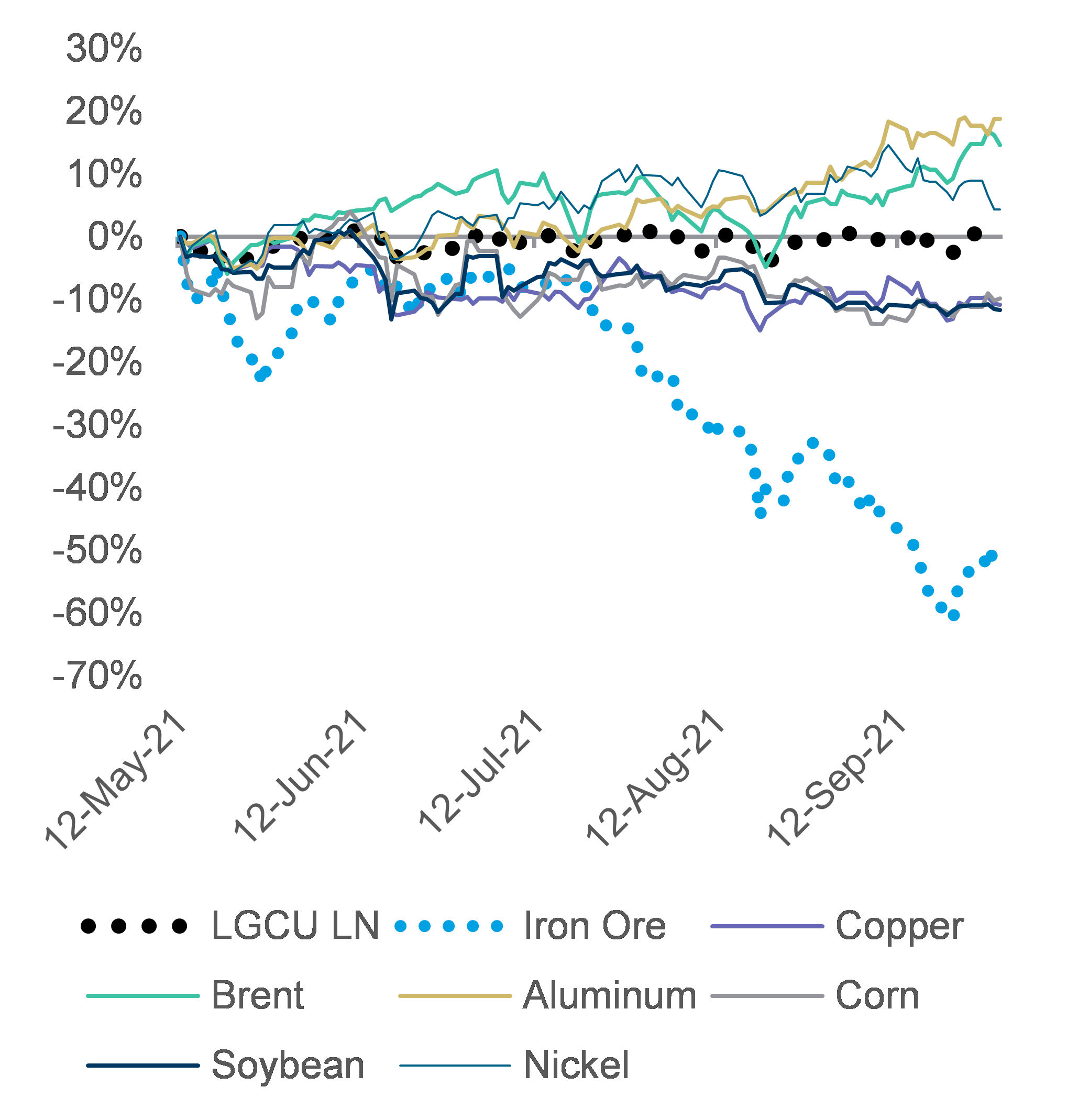
Source: Bloomberg, Morgan Stanley Wealth Management. Percentage change from 12 May 2021 to 29 September 2021.
2. Fiscal policy remains a critical driver for this cycle
China and the US remain the two largest global economies representing approximately 43% of global GDP. Morgan Stanley expects key fiscal policy developments from both countries.
As recently noted by Chetan Ahya, Morgan Stanley's Chief Asia Economist, Chinese property developers facing near term funding risks have been a significant overhang on the market which we believe will be the catalyst for a policy pivot by Chinese authorities.
The current situation results from the "three red lines" policy announcement in August 2020, whereby the Chinese government required property developers to maintain healthy liabilities-to-assets, net gearing and cash-to-short-term debt ratios. The purpose of these measures was to reduce systemic risk by curbing excessive property sector borrowing. Most companies have been able to comply, but a number face challenges. While we believe the overall debt situation for the property development sector is manageable, there are negative consequences for residential property investment, and goods and services tied to housing which account for ~15% of China's GDP. Morgan Stanley estimates that a 10% decline in residential property activity could be a ~1% drag on GDP growth.
The spillover from this negative wealth effect due to a weak housing market joins:
1. Industrial production cuts to meet energy intensity targets.
2. Corporate sentiment is subdued because of actions taken by regulators against the technology sector.
3. Consumption is softening due to rolling Covid-19 lockdowns, which collectively add to substantive near-term growth risk for China's economy.
The stage is now set for China to loosen its monetary policy and accelerate fiscal stimulus into the economy in the coming weeks and months. We anticipate the first sign of easing will occur at the October Central Economic Work Conference, which sets the national growth plan for the coming year.
Michael Zezas, Morgan Stanley's Chief US Public Policy Strategist, still believes the US$4.5 trillion infrastructure and social spending packaging currently being negotiated by the US Congress remains on track for passage by December. Even with some negotiated reduction to the headline spending figures, the two pieces of legislation can potentially increase the government's deficit by approximately 1% for the next five years, which would have an outsized stimulatory impact on the economy.
We acknowledge a critical vote scheduled for Thursday in Washington will play a deciding role in the overall success of this legislation. For now, we maintain our base case that deficit fueled stimulus is on its way.
3. Previous fiscal stimulus remains unused
Morgan Stanley estimates previous fiscal
payments by major governments around the world remain largely unspent by
households. For example, we estimate US households have excess savings of
US$2.2 trillion, which is equivalent to about 10% of US GDP. Chinese families
have US$704 billion in excess savings, equal to about 5% of China's GDP. The
Euro Area has excess savings of US$550 billion, equivalent to approximately 4%
of EUA GDP. Lastly, in Australia, we estimate excess savings of A$190 billion,
equal to about 9% of our GDP.
Collectively,
it means the major consuming nations of the world have substantial reserves to
support and potentially accelerate consumption as Covid-19 impacts wane in the
coming months.
4. Covid-19 is increasingly in the rearview mirror
While case counts remain elevated, increasingly, countries appear to be shifting to the view that Covid-19 will become endemic or something that we will have to live with, like malaria. This shift should lead to greater attention on minimising but not eliminating the worse outcomes from Covid-19. How well we manage Covid-19 will be hospitalisation rates as we need to ensure our collective healthcare systems are not overwhelmed by severe Covid-19 cases. As seen in Exhibit 3, as the global vaccination program gains pace, hospitalisation rates per million have remained well below previous peaks. In our cross-sample of large countries where we have data, it appears vaccines are having the desired effect of helping us live with Covid-19.
Morgan Stanley biotech analysts also highlight three oral pills in Phase III clinical trials for the treatment of Covid-19: Merck/Ridgeback's molnupiravir, Atea's AT-527 and Pfizer's PF-07321332. Our analysts expect AT-527 will have sufficient data before the end of the year to allow Emergency Use Authorisation (EUA), the same route that many of the current Covid-19 vaccines took to market.
Exhibit 3 – Number of Covid-19 patients in hospital per million
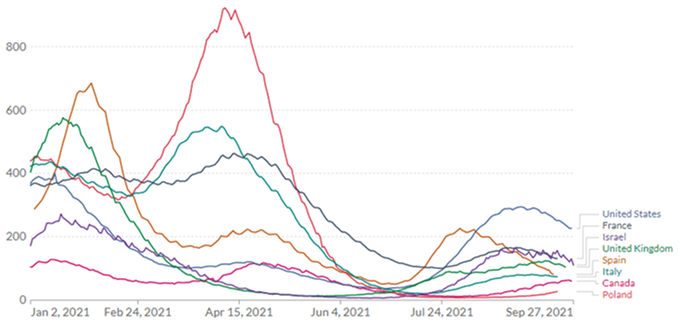
Source: European CDC for EU countries, government sources for other countries – Last updated 27 September, 14:00 (London time). OurWordInData.org/coronavirus
5. Economic data has slowed but is still good
The rise of the Delta variant has negatively impacted macroeconomic data over the last several months. That said, while the rate of growth has slowed, global economic conditions remain expansionary. We observe that the Manufacturing PMI readings for the US, China, Eurozone, and Japan, which collectively represent approximately two-thirds of the global economy, remain above 50, the key level indicating growth in the industrial portion of the economy (Exhibit 4). The Services PMI reading (Exhibit 5) is more mixed but arguably remains hindered by government policies limiting this portion of the economy (restaurants, travel and entertainment). In comparison to the economic dislocation caused by Covid-19 last year, we are a long way from an alarming deceleration in economic activity.
Exhibit 4 – Manufacturing PMIs remain above 50
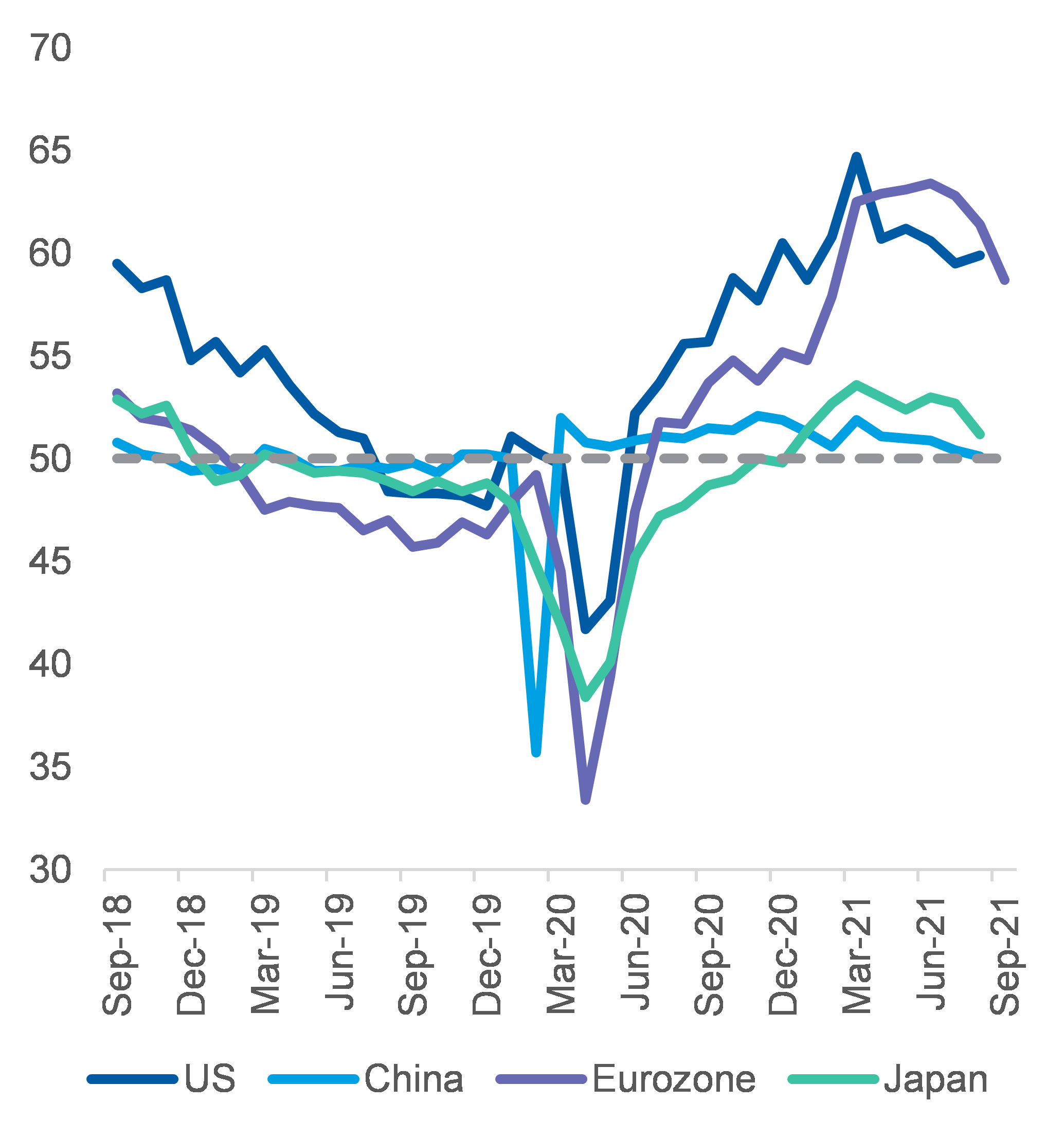
Source: Bloomberg, Morgan Stanley Wealth Management. As at 29 September 2021.
Exhibit 5 – Service PMIs mixed
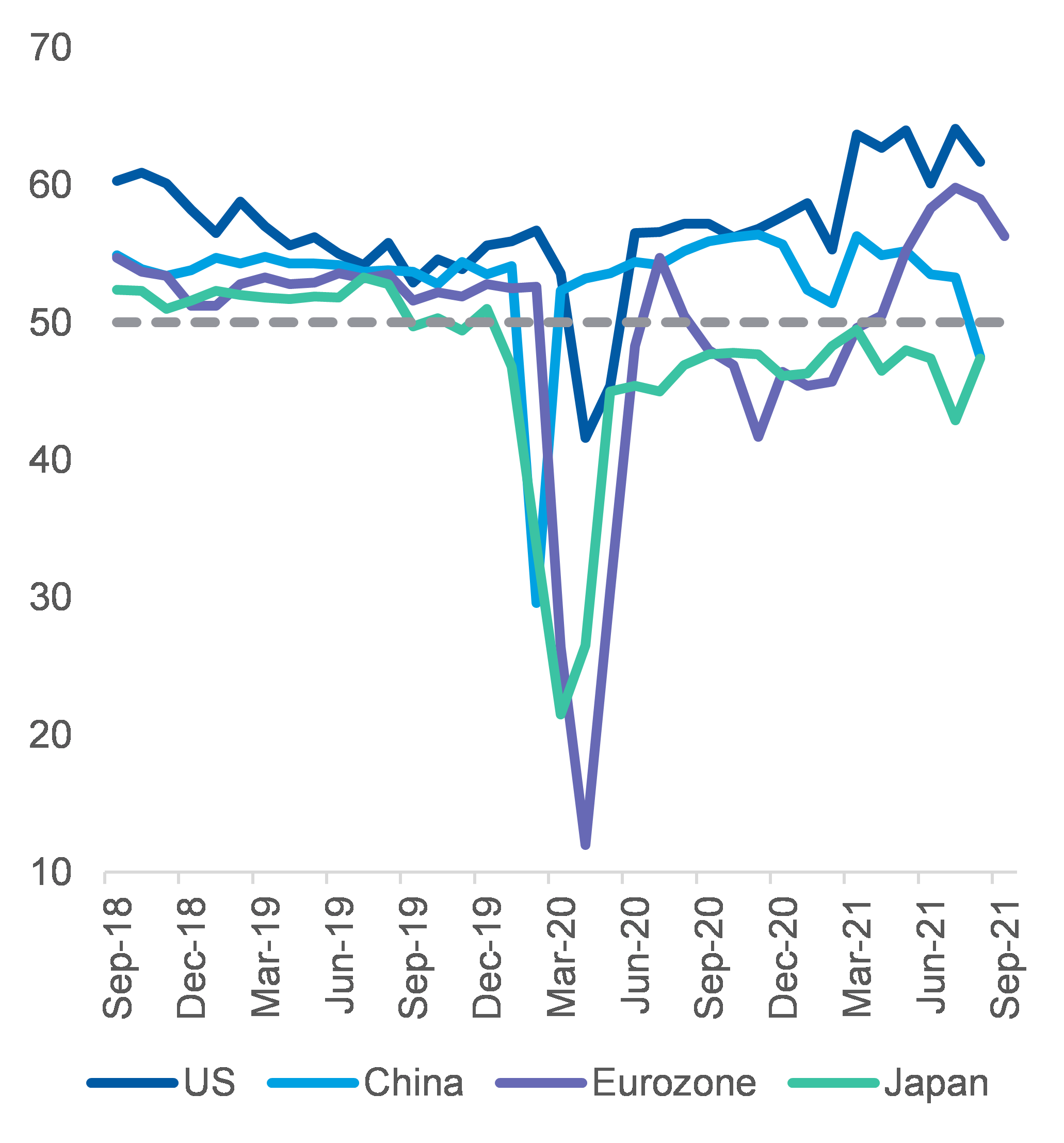
Source: Bloomberg, Morgan Stanley Wealth Management. As at 29 September 2021.
Medium-term confident, short-term cautious
While we believe there
remains plenty of growth for this cycle and several major drivers should
continue to be supportive, we see short term market risk from a deceleration in
consensus earnings estimates. As noted by Mike Wilson, Morgan Stanley's Chief
Investment Officer, "cost pressure" is increasingly mentioned by US
corporates. Covid-19 continues to impact supply chains, labour costs are
rising, and raw material inflation all contribute to cost inflation which we
believe will not be easily offset by higher prices. This should lead to
downward earnings revisions for aggregate consensus profit forecasts (see
Exhibit 6).
Exhibit 6 - Historically, Margins Consolidate After a Surge in “Cost Pressure” Mentions—We Could Be Headed for a Repeat of This, and Consensus May Be Too High on Margins Through 2022
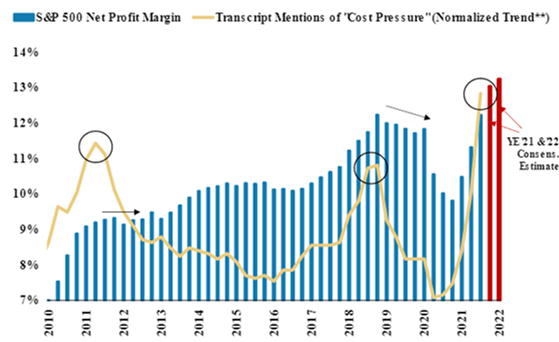
Source: AlphaSense, FactSet, Morgan Stanley Research. Pulled from earnings transcripts, sales updates, guidance updates, conference presentations, analyst / investor / shareholder meetings. **The normalized trend is calculated as a function of the number of documents containing hits on the keyword and the total documents that would be found for the same search without the keyword. Some searches are based on slight derivations of the term in quotes. Universe is US public companies with market caps >US$500M.
Chris Nicol, Morgan Stanley's Chief Australian Equity Strategist, sees a similar dynamic with consensus profit forecasts in Australia. Iron ore price weakness, lockdown-related disruptions and incremental headwinds to bank earnings are already leading to downgrades in FY22 earnings (see Exhibit 7). We suspect some of the downgrades reflect the deferral of sales into FY23 due to the extension of lockdown conditions in New South Wales and Victoria, but it does not change that near term, earnings estimates are heading the wrong way.
Exhibit 7 – Aggregate Consensus Annual EPS Growth
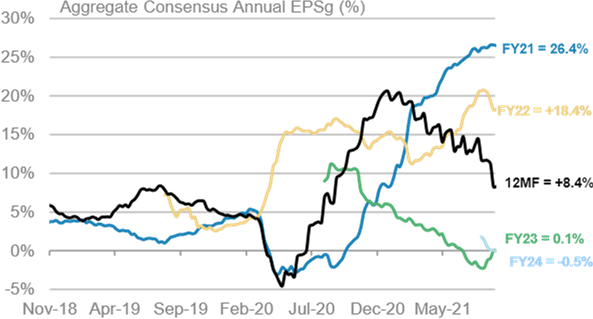
Source: IBES, Rimes, Morgan Stanley Research
The loss of earnings momentum typically coincides with increased equity market volatility, which keeps us cautious in the immediate future. So while macro conditions keep us overweight in Growth assets, we will be leaning on our Defensive holdings in the coming weeks to smooth out our model portfolio volatility.
Positioning
In our model portfolio, we continue to recommend investors to rotate within their Growth and Defensive assets. Within Growth assets, we prefer the reopen laggards and the Value factor, leading us to favour Europe and Japan over the US. Narrowing to sectors, we choose Energy and Financials. For those with a view that equity market volatility might not be as transient, consider adding the Minimum Volatility factor.
Keep some allocation to high-quality government bonds within your Defensive assets, but we continue to prefer subinvestment grade, variable rate corporate securities. We believe that default risk for corporates remains relatively low and like to take on greater default risk in return for higher interest income. Again, if you believe equity market volatility might persist, cash is the ultimate short term safe haven.
Exhibit 8 – Suggested exposures from Morgan Stanley's Focus List
Please click 'Contact' if you would like a copy of the full Morgan Stanley report.
Specialist advice from Morgan Stanley
Morgan Stanley Australia focuses on providing individuals and institutions with specialist strategic advice and then helping implement these strategies through superior investment execution. For more of my insights, follow me here.
3 topics
1 contributor mentioned

